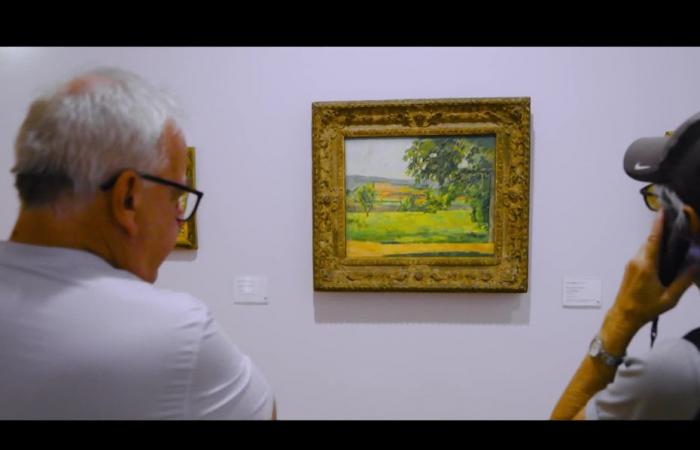This is the major cultural event of next year in Aix-en-Provence. Nearly 120 years after his death, Paul Cezanne will be honored in an unprecedented way in his city of birth. For 100 days, from the end of June to mid-October, the artist’s places of life and creation will be open to the public and a major international exhibition will be presented at the Granet museum.
The essentials of the day: our exclusive selection
Every day, our editorial team reserves the best regional news for you. A selection just for you, to stay in touch with your regions.
France Télévisions uses your email address to send you the newsletter “The essentials of the day: our exclusive selection”. You can unsubscribe at any time via the link at the bottom of this newsletter. Our privacy policy
“We are on edge in relation to the organization itself, in particular in relation to the recruitment of staff, and also in relation to the management of questions of security and insurance of the boards”. Seven months before the launch of “Cezanne 2025”, the director of the Granet museum is starting to feel the organizational pressure mounting. Regarding the content of the exhibition, however, Bruno Ely appears calm, but above all satisfied and proud of the work carried out. From June 28 to October 12, its museum will host nearly 130 works by the artist from around the world, on loan from prestigious museums and private collectors. “Organizing a Cezanne exhibition is always a performance. Obtaining loans of Cezanne paintings is becoming more and more difficult because collectors, major institutions, such as the Metropolitan Museum of Art in New York, the National Gallery in Washington, or the Nakata Museum in Tokyo for example, are museums which keep their works and therefore it is always very difficult for them, and even for a collector, to temporarily part with their paintings.
Among the paintings he is delighted to receive are “Les Joueurs de cards” exhibited in Paris at the Musée d’Orsay, two “Sainte Victoire”, still lifes painted at the Jas de Bouffan or paintings made directly on the walls of the Jas de Bouffan, then detached and preserved throughout the world, but which the museum managed to obtain.
Paul Cezanne, The Card Players, between 1890 and 1895 Oil on canvas, 47 x 56.5 cm Paris, Musée d’Orsay Bequest of Count Isaac de Camondo, 1911
•
© © Musée d’Orsay, Dist. RMN-Grand Palais / Patrice Schmidt
In addition to this major exhibition, the Cezanne year will also be an opportunity for the public to discover the artist’s places of life, creation and inspiration. Starting with the bastide town of Jas de Bouffan. This family home, purchased by his father in 1859, remained his anchor in Aix for 40 years. It was there that he began his career. He painted his nine large wall panels directly on the walls of the large living room. One of his works emerging from a plaster wall was also unveiled last February.
Thanks to its park, its agricultural buildings and its view of the Sainte-Victoire mountain, the bastide also becomes one of the inspirations for Cezanne’s paintings. The public will be led to discover the place through a stroll going from the Grand living room through the kitchen, the bedroom decorated on the theme of Leda and the Swan and the painter’s studio on the second floor. Currently undergoing renovation, the bastide, purchased by the city in 2018, will reopen alongside the exhibition at the Granet museum, then will be closed again for work.
The Bastide du Jas de Bouffan, Aix-en-Provence
•
© photo M. Fraisset
Another emblematic site: the Lauves workshop where he painted during the last four years of his life between 1902 and 1906. This workshop was built in 1901 on the artist’s own plans, on the Lauves hill, above above the city of Aix-en-Provence. Transformed into a museum since 1954, it has been restored over the last two years and will offer, from the end of June, an immersion into the world of the Provençal master thanks in particular to an immersive tour and the authentic rehabilitation of his garden.
Interior of Cezanne’s studio on Lauves hill in Aix-en-Provence
•
© Photo JC Carbonne, City of Aix-en-Provence
Finally, the Bibémus quarries redeveloped since 2022 by the city of Aix-en-Provence and another motif dear to the painter, will also be part of the heritage places highlighted during the event.
Bibémus quarries, Aix-en-Provence
•
© Photo M. Fraisset
“The common thread of the exhibition is “Cezanne at home””, explains Sophie Joissains, the mayor of Aix-en-Provence. But the approach goes well beyond the simple intention of exhibition. Bringing all these works by Cezanne back to Aix, and rehabilitating its places of life and creation, is a city’s homage to its painter. The most beautiful proof of recognition for the country’s child, and for his genius which has remained neglected by his city for too long. Considered the father of modern art, he was ahead of his time and was maligned in his city, so much so that the curator of the Granet museum around 1900 is said to have exclaimed “As long as I am alive, no Cezanne will enter the museum” . His innovative pictorial technique was misunderstood in the still very academic circles of Aix. Which explains why few of his works were acquired by Aix and found themselves scattered throughout the world among collectors or in museums more open to avant-gardism. We had to wait until 1984 to see eight paintings by the Aix painter, who then did not own any, enter the Granet museum. Forty years later, with this large-scale operation, it is a bit as if the damage was repaired, and Aix-en-Provence moved from being the cradle of the artist to that of its museum city.
It is in this sense that “Cezanne 2025” is experienced as an outcome for the painter’s great-grandson.“It’s decades of work to be able to understand all the interest of the painter and all the brilliance that this can bring to a city. We arrive at a sort of finalization with in particular the restoration of the Jas de Bouffan which was his cocoon”explains Philippe Cézanne, present at the presentation of the event at the Aix-en-Provence town hall this Monday, November 25. The painter’s descendant also recounts how much his grandfather suffered from Aix’s lack of consideration for his father Paul Cezanne: “When Cezanne died, his son, my grandfather, emptied the apartment and the studio said ‘since the people of Aix do not like my father, I will never come back’. Today is the start of a great adventure. I find it fascinating to experience.”
Philippe Cézanne, the great-grandson of Paul Cezanne.
•
© Gilles Ammar / FTV
For three months, Aix will vibrate in the colors of Cezanne. In addition to the Granet museum, other places will be offered to the public to make the evocation of the Aix painter even more powerful. The Musée du Vieil Aix will return to the links between Aix and Cezanne, the Musée du Pavillon de Vendôme will take us back to the Cezanne exhibitions of 1956 and 1961. Finally, children from three years old will also have their tailor-made Cezanne exhibition with the opening of La Petite Galerie Cezanne designed at children’s eye level at La Manufacture.
With its rehabilitated places, its major exhibition at the Granet museum, and other initiatives aimed at the public, the Cézanne year, which required four years of preparation, also represents a big investment for the city which hopes that the tourist benefits will be the height of the event. The tourist office is already traveling internationally to promote it. The budget amounts to nearly 12 million euros. Amortized by public subsidies, but also by patrons. A part will also be absorbed by the ticket office which will open in December 2024. At least 350,000 visitors are expected.





